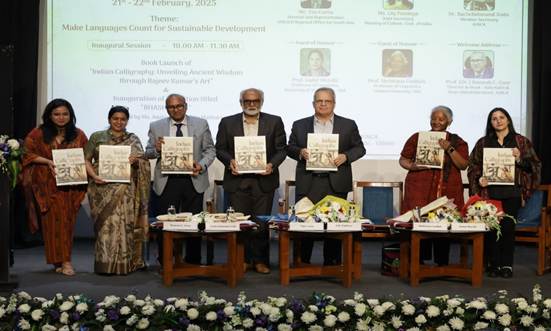IGNCA commemorated International Mother Language Day with a two-day celebration on 21st and 22nd February 2025 New Delhi. Asal Baat News. ...
IGNCA commemorated International Mother Language Day with a two-day celebration on 21st and 22nd February 2025
New Delhi.
Asal Baat News.
Indira Gandhi National Centre for the Arts (IGNCA) commemorated International Mother Language Day with a two-day celebration on 21st and 22nd February 2025. Centred on the theme ‘Make Languages Count for Sustainable Development’, the event brought together eminent scholars, linguists, and cultural experts to deliberate on the role of languages in fostering sustainable growth. The inaugural session on 21st February featured the launch of ‘Indian Calligraphy: Unveiling Ancient Wisdom through Rajeev Kumar’s Art’, alongside the inauguration of the exhibition BHASHARRITI, curated by Ms. Aashna and Ms. Ritu Mathur. The occasion was graced by Mr. Tim Curtis, Director and Representative, UNESCO Regional Office for South Asia, as Chief Guest, and Ms. Lily Pandeya, Joint Secretary, Ministry of Culture, Government of India, as Special Guest.
The session was chaired by Dr. Sachchidanand Joshi, Member Secretary, IGNCA, and the welcome address was delivered by Prof. Ramesh Chandra Gaur, Director & Head- Kala Nidhi and Dean (Administration), IGNCA. The event provided a dynamic platform for insightful discussions, reinforcing a collective commitment to preserving and promoting linguistic heritage.

(L-R) Ms. Ashna , Ms. Ritu Mathur, Prof. Ramesh Chandra Gaur, Dr. Sachchidanand Joshi , Mr. TIm Curtis. Prof. Shobhana Chelliah, Prof. Sadaf Munshi Launching the book at the Event
Mr. Tim Curtis and Prof. Ramesh Chandra Gaur walking through the Exhibition
Mr. Tim Curtis, while delivering his address, emphasised that celebrating International Mother Language Day is deeply personal and universally significant, as it honours the languages that shape our thoughts and words. More than mere tools of communication, languages define identities and connect individuals to their histories and communities. Highlighting South Asia’s rich linguistic landscape, he noted that research indicates over 7,000 languages are endangered, with indigenous languages being the most vulnerable. These languages encapsulate unique knowledge systems and millennia of wisdom, making their loss a threat to cultural heritage.
He referred to the United Nations’ declaration of 2022–2032 as the Decade of Indigenous Languages, aimed at documentation, revitalisation, and celebration of linguistic treasures. He acknowledged IGNCA’s ongoing contributions in this regard and expressed gratitude for organising Mother Language Day. Stressing the importance of multilingual education, he cited India’s National Education Policy as a model for embracing linguistic diversity, enhancing both learning outcomes and national unity. UNESCO, he affirmed, is scaling up efforts for indigenous language preservation, advocating community-led initiatives that bridge linguistic communities and foster equity.Mr. Tim Curtis concluded by stating that language is not just a tool for communication but, in a way, a passport to understanding humanity itself. When we speak in our mother tongue, we do not merely exchange words but share ways of perceiving and interpreting the world. By honouring each other’s mother tongue, we facilitate understanding that transcends borders and cultures Dr. Sachchidanand Joshi, in his chair remarks, stated that it is always a pleasure to acknowledge that India is a nation with one of the highest numbers of languages and dialects. With over 1,700 languages once spoken across the country, this linguistic wealth has long been a matter of pride. However, the other side of the coin is the rapid decline of languages, with many disappearing at an alarming rate, an issue that warrants serious concern. He emphasised that collective efforts are being made to preserve and promote languages, and the National Education Policy rightly places significant emphasis on education in one’s mother tongue. While discussing language, he noted that it consists of three fundamental components-language itself, script, and phonetics. He pointed out that among these, phonetics remains the most overlooked aspect in conversations about mother tongues. Without attention to phonetics, he asserted, a language remains incomplete.



 "
"




 "
"
 "
"
 " alt="" />
" alt="" />
 " alt="" />
" alt="" />





